
The conservation status of a group of organisms indicates whether the group still exists and how likely the group is to become extinct in the near future. Many factors are taken into account when assessing conservation status: not simply the number of individuals remaining, but the overall increase or decrease in the population over time, breeding success rates, and known threats. Various systems of conservation status are in use at international, multi-country, national and local levels, as well as for consumer use such as sustainable seafood advisory lists and certification. The two international systems are by the International Union for Conservation of Nature (IUCN) and The Convention on International Trade in Endangered Species of Wild Fauna and Flora (CITES).
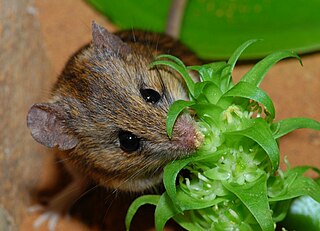
The Namaqua rock rat is a species of rodent in the family Muridae. It is sometimes included in the genus Micaelamys. It is found in Angola, Botswana, Lesotho, Malawi, Mozambique, Namibia, South Africa, Eswatini, Zambia, and Zimbabwe. Its natural habitats are temperate forest, dry savanna, temperate shrubland, subtropical or tropical dry shrubland, temperate grassland, rocky areas, hot desert, temperate desert, rocky shores, arable land, rural gardens, and urban areas.
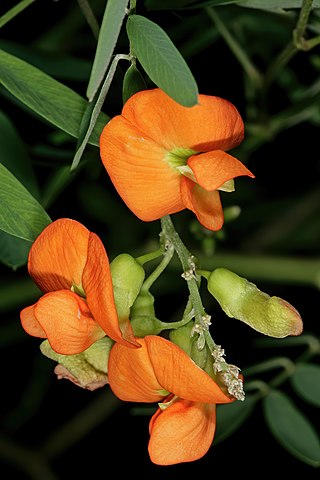
Tephrosia pondoensis is a species of plant in the family Fabaceae. It is found only in the Cape Provinces of South Africa, where it is protected under the National Forest Act of 1998. The pondo poison pea is threatened by habitat loss.

Umtiza is a monotypic genus in the legume family Fabaceae containing the single species Umtiza listeriana. This tree is endemic to a small coastal portion of the Eastern Cape in South Africa.

Widdringtonia wallichii, Clanwilliam cedar or Clanwilliam cypress, previously Widdringtonia cedarbergensis is a species of Widdringtonia native to South Africa, where it is endemic to the Cederberg Mountains northeast of Cape Town in Western Cape Province. Due to harsh weather conditions, like limited rainfall and frequent wildfires, growth is limited. Ring width almost correlates with rainfall due to such harsh environmental conditions It is threatened by habitat loss and protected in South Africa under the National Forest Act of 1998.
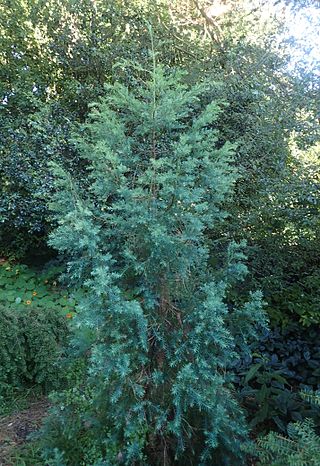
Widdringtonia schwarzii is a species of Widdringtonia native to South Africa, where it is endemic to the Baviaanskloof and Kouga Mountains west of Port Elizabeth in Eastern Cape Province; it occurs on dry rocky slopes and crags at 600–1,200 m altitude. It is threatened by habitat loss, particularly by wildfire. The Willowmore cypress is a protected tree in South Africa.

The Karoo toad, Gariep toad, or mountain toad is a species of toad in the family Bufonidae found in southern Namibia, much of South Africa, Lesotho, and Eswatini. It is an abundant species that occurs in many types habitat: fynbos heathland, succulent karoo, thickets, grassland, and Nama Karoo. Breeding takes place in permanent and temporary waterbodies. There are no significant threats to this adaptable species.

The Namaqua rain frog or Namaqua short-headed frog is a species of frogs in the family Brevicipitidae. It is found in Namaqualand in western South Africa and extreme southern Namibia.
Cassipourea swaziensis is a species of plant in the Rhizophoraceae family. It is found in South Africa and Eswatini. It is threatened by habitat loss, and a protected tree in South Africa.

Erythrophysa transvaalensis is a species of plant in the family Sapindaceae. It is a protected tree in South Africa. It is found in Botswana, South Africa, and Zimbabwe. Its range is disjunct however, so that suggestions have been made that its seeds were formerly employed as beads, which assisted its dispersal along ancient trade routes.

Protea comptonii, also known as saddleback sugarbush, is a smallish tree of the genus Protea in the family Proteaceae. It is found in South Africa and Eswatini.
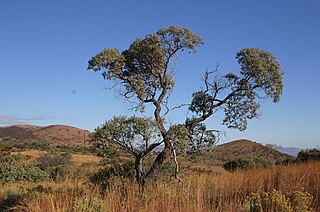
Ozoroa paniculosa, commonly known as the bushveld ozoroa or common resin tree, is a small tree belonging to the mango family or Anacardiaceae. It is native to southern Africa, where it occurs in Zimbabwe, South Africa, Mozambique, Botswana and Namibia. It grows to a height of about 6 metres at high elevations, but may reach 15 metres in warmer, low-lying areas. This genus currently has some 28 species and occurs from southern Africa to the Arabian Peninsula.
Colubrina nicholsonii is a species of tree in the family Rhamnaceae. It is a protected species endemic to South Africa. The plant grows in subpopulations in isolated gorges, usually of 10-20 and less than 50 individuals overhanging water. It is estimated that there are no more than 1,000 individuals in the wild.

Protorhus longifolia, the red beech, is a medium to large, mostly dioecious species of tree in the family Anacardiaceae. It is native to South Africa and Eswatini, where it occurs in well-watered situations from coastal elevations to 1,250 m. The leafy, evergreen trees have rounded crowns and usually grow between 6 and 10 m tall, but regularly taller in forest.
The Namaqua rock gecko or Namaqua flat gecko is a species of African geckos found in South Africa.
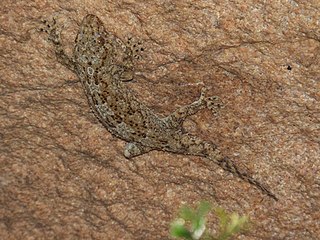
The Namaqua thick-toed gecko is a species of lizard in the family Gekkonidae. It is found in Namibia and South Africa.
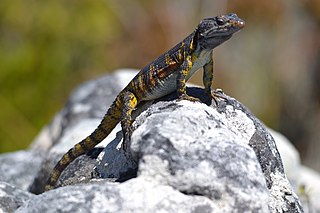
Pseudocordylus microlepidotus, or the Cape crag lizard, is a species of lizard native to shrublands and grasslands of South Africa. Three subspecies have been named: Pseudocordylus microlepidotus microlepidotus, Pseudocordylus microlepidotus fasciatus, and Pseudocordylus microlepidotus namaquensis. The species' gestation type is ovoviviparous. The species is protected under Convention on International Trade in Endangered Species of Wild Fauna and Flora (CITES).

Pedioplanis namaquensis, known commonly as the Namaqua sand lizard or l'Érémias namaquois, is a species of lizard in the family Lacertidae. The species is endemic to Southern Africa.
Acontias namaquensis, the Namaqua legless skink or Namaqua lance skink, is a species of lizard in the family Scincidae. It is endemic to Little Namaqualand, Northern Cape, South Africa.
The Namaqua girdled lizard is a species of small, spiny lizard in the family Cordylidae. The species is native to Namibia and South Africa.















